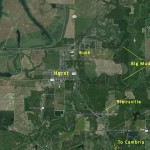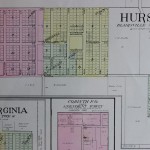Hurst, a city in section 18 of Blairsville Township, was platted in 1903 while the railroad was being built from the Mississippi river to the northwest corner of the county. W.C. Hurst, a railroad official, and T.P. Russell rode horseback over the latter’s farm and laid out a town that surveyors afterward made more regular.
 Land was given for the town plat by John Edmonds, T.P. Russell and Johnson Hubbs. The first building was the lumber yard finished July 4, 1903 by Mr. Russell and Andrew J. Zimmerman. The former came to the new town from his work in a grocery store at Blairsville and opened the Hurst store company, later the Russell-Zimmerman store.
Land was given for the town plat by John Edmonds, T.P. Russell and Johnson Hubbs. The first building was the lumber yard finished July 4, 1903 by Mr. Russell and Andrew J. Zimmerman. The former came to the new town from his work in a grocery store at Blairsville and opened the Hurst store company, later the Russell-Zimmerman store.
W.C. Hurst was assistant superintendent of the Illinois division, St. Louis, Iron Mountain and Southern railroad, a part of the Missouri Pacific system. A branch line was built in 1903 from De Soto to the Franklin-Williamson County line. Mr. Hurst was in the neighborhood frequently and stayed with Mr. Russell at his Blairsville home. Mr. Russell wished the new town to bear his family name that of the country school district near the town site, but other Illinois towns had preempted the name Russell. The name of this friend was suggested, and so the town was christened. William Charles Hurst was born in 1877 at Durham, England and grew up at St. Joseph, Missouri. He entered the railroad service as a water boy in 1890 and is now senior vice president of the Chicago and Illinois Midland Railroad at Springfield.
The name Hurst was not strange to the neighborhood. David Hurst came there shortly after the Civil war and raised a large family of a farm just across the county line in Jackson County. His daughter, Mrs. Phil Howard was still living in Hurst in 1939. William T. Hurst made a land entry in 1859 where the village of Freeman Spur now stands.
The railroad was completed to the Franklin-Williamson county line September 1, 1903. A controversy over the location of the station ended with its being placed in Bush, and the community called Hurst-Bush. Separate villages were incorporated, and only the school district retained the composite name.
Hurst post office was opened January 24, 1905 with Andrew J. Zimmerman in charge. A village charter was secured on December 29 following. Mr. Zimmerman turned over the post office to Ezekial Tambrough June 29, 1906 and devoted himself to the hardware, real estate, loan and insurance company in which Mr. Russell was a partner.
Edgar Pulley served ten years as postmaster, from May 17, 1907 to June 2, 1917. Then Charles B. Springer succeeded him.
Meantime, Hurst had acquired a bank and become a city. The Carterville-Hurst Bank was organized as a private institution in 1908; the officers, John Edmonds, M.W. Sizemore of Carterville, and T.P. Russell. Mr. Edmonds was one of the village trustees at Hurst and made the western addition to the town plat, bringing the western limits to the Jackson County line. The bank remained in operation until 1930. The city charter was granted February 25, 1919. On the following May 5, Hurst citizens approved the commission form of government. W.S. Murphy was elected the first mayor.
Charles W. Russell became postmaster May 5, 1922. He was a brother of the bank cashier and founder of the town, Thomas P. Russell (1866-1930). Both were grandsons of William Washington Russell, who did not let his sixty three years interfere with enlistment the day of the muster at Russell Corners.
When Postmaster Russell died, his daughter, Mrs. Sara Warder was appointed his successor December 22, 1926. She was followed by Clyde S. Coyle January 23, 1930. On June 1, 1934, George G. Vaughan handled the Hurst mail.
Twenty acres that form the eastern part of Hurst was the gift of Johnson, or Johns, Hubbs. He was among the farmers who watched the town grow and took full advantage of its business opportunities. Mr. Hubbs managed the mill and the livery stable, and built the largest barn the countryside ever saw. The Christian Church once stood east of the town, near the Hubbs’ farmhouse, and Mrs. Hubbs was a devoted member. She too was a granddaughter of one of the settlers at Russell Corners, Philip Jefferson Russell.
(Extracted from Pioneer Folks and Places, Barbara Barr Hubbs, 1939, on sale at the Williamson County Museum)

